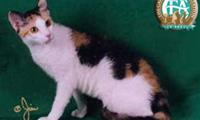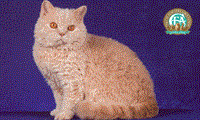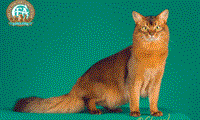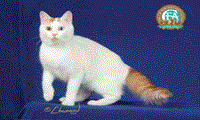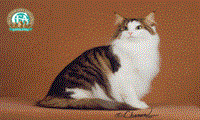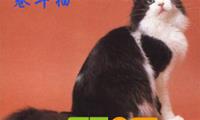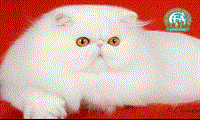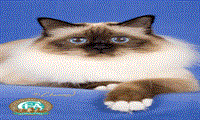
起源與產地
埃及是埃及貓最早出生地, 在家貓的歷史中埃及貓可能是最早出現的。
性情
埃及貓的性格溫順, 聰明且記億力很好, 對於小孩子埃及貓很有耐心, 它的叫聲輕細而優美。 膽小脆弱, 害怕陌生人。

特徵
頭部:呈現略圓的楔形且大小適中, 額頭到鼻樑部分有些隆起。 額頭、臉頰和側臉較為豐滿。 嘴不尖、公埃及貓的下齶較發達。
耳朵:耳朵大且耳朵的端部略尖向前傾。 耳朵外側的毛較短並且很密, 在耳朵的內側長有向外側伸出並捲曲的飾毛。
眼睛:呈杏仁形的眼很大,
軀體:埃及貓的身材適中, 苗條, 強健的肌肉中最為發達的還屬頸和肩兩部分。
四肢:都較長且後腿要長於前肢。 肢體協調, 並且能用爪尖站立起來。
趾:呈現稍圓的小的卵形。
尾:尾巴的長度中等, 尾尖部分較細, 根部較粗。
被毛:光滑、柔軟、有光澤。 埃及貓身體的每個部位有很多種斑紋, 這是它最大的特徵。 額頭有"M"形狀花紋並且臉頰也有花紋的是典型的埃及貓。 在他的頸部有呈細線形狀的花紋, 在肩部有較寬的條紋, 肩部往後的部分為斑點狀花紋, 喉部的項鍊花紋斷成兩節,
毛色:毛色主要有三種。
銀色:淡銀色的底色, 有黑斑在沒有規則的銀色條紋上, 黑線包圍鼻、唇和眼的邊緣, 磚紅色的鼻鏡, 足趾間的顏色為黑色。
古銅色:淡棕色的底色, 有巧克力色斑點在沒有規則的古銅色條紋上, 棕褐色線包圍鼻、唇和眼的邊緣, 磚紅色的鼻鏡, 足趾間的顏色為棕褐色或黑色。
煙色:深灰色的底色, 灰色中帶有黑斑, 絨毛為銀色, 黑線包圍鼻、唇和眼的邊緣, 黑色的鼻鏡, 足趾間的顏色為黑色。
缺點:劣種埃及貓圓頭且短, 耳朵較小, 嘴尖, 體態頗胖。 如尾巴扭曲嚴重,多趾, 身上有白色斑點者為劣品。
CFA官方關於埃及貓品種簡介
Breed Profile: Egyptian Mau
The Egyptian Mau is a fascinating cat, not only because of its past history, but because of its delightful personality and striking appearance.
The Mau (mau is the Egyptian word for cat) has been clearly identified in the artwork of the ancient Egyptians, leaving no question in the minds of many experts that the Egyptian Mau is indeed the cat domesticated from a spotted subspecies of the African Wild Cat by this unique culture. To gaze upon this beautiful and engaging creature is an opportunity to view a living relic.
The role of the Mau in the religion, mythology, and everyday life of the Egyptian conveys the degree of affection and respect in which these cats were held. They were worshipped as deities, cherished as pets, protected by laws, and mummified and mourned upon their death.
Their history in North America began with their importation in 1956 by the exiled Russian princess, Nathalie Troubetskoy. Recognition by The Cat Fanciers’ Association (CFA) for championship competition came in 1977. In the past, all Egyptian Maus in the U.S. and Canada traced their ancestry to two of the original imports from the Fatima Cattery. Recent importations have enriched and broadened the available gene pool for breeders.
The Egyptian Mau has the distinction of being the only natural spotted breed of domestic cat. An extremely intelligent animal, the Mau places a great importance on family, both human and their own, and is fiercely loyal in his devotion to them. They are moderately active and often express their happiness by chortling in a soft melodious voice and wiggling their tails at great speed while treading with their forepaws.
With an elegant body that is randomly spotted, banded legs and tail, expressive gooseberry green eyes, distinctive mascara lines, a worried expression on the face, and a graceful cheetah-like stride, it is no wonder that the Mau attracts such a tremendous amount of attention at cat shows.
The Egyptian Mau comes in three colors that can be shown in championship classes: Silver, Bronze, and Smoke. Also accepted for registration purposes, but not for showing, are the solid Black and the dilute versions of the "primary" colors: Blue Silver, Blue spotted (dilute bronze), Blue Smoke and the solid Blue. Although the black and the dilute Maus are not eligible for showing, they make excellent pets like all other Maus. .
Pricing on Egyptian Maus usually depends on type, applicable markings and bloodlines distinguished by Grand Champion (GC), National or Regional winning parentage (NW or RW) or of Distinguished Merit parentage (DM). The DM title is achieved by the dam (mother) having produced five CFA grand champion/premier (alter) or DM offspring, or sire (father) having produced fifteen CFA grand champion/premier or DM offspring. Usually breeders make kittens available between twelve and sixteen weeks of age. After twelve weeks, kittens have had their basic inoculations and developed the physical and social stability needed for a new environment, showing, or being transported by air. Keeping such a rare treasure indoors, neutering or spaying and providing acceptable surfaces (e.g. scratching posts) for the natural behavior of scratching (CFA disapproves of declawing or tendonectomy surgery) are essential elements for maintaining a healthy, long and joyful life.
